Would you like to know how to boost your rankings using the Search Statistics feature?
Having a clear picture of how your content is performing is a critical element to better optimize your content for search engines and users. It can also help you fine-tune your SEO strategy so you outrank your competitors and dominate search engine results pages (SERPs).
In this article, we’ll show you how to use the Search Statistics feature in All In One SEO (AIOSEO) to boost your rankings.
In This Article
- What Is Search Statistics?
- 1. Keep Tabs on Winning and Losing Content
- 2. Boosting Your Rankings in Positions 2-4: Increase Your Clickthrough Rates (CTR)
- 3. Boosting Your Rankings in Positions 4-7: Boost Your Visibility
- 4. Boosting Your Rankings in Positions 7-10: Audit Your Content
- 5. Boosting Your Rankings in Positions 10-15: Audit Your Technical SEO
- 6. Boosting Your Rankings in Position 15-20: Perform Competitor Analysis
- Search Statistics Power Hacks: Boosting Your Rankings and Growing Your Business.
What Is Search Statistics?
Search Statistics is a powerful Google Search Console (GSC) integration in AIOSEO. GSC is a free tool from Google that helps you analyze your website and monitor its performance.
So why did we integrate GSC into AIOSEO?
We added the GSC integration because GSC’s reports are not user-friendly, especially for beginners. So we’ve simplified the reports making it easier for anyone to use them. Secondly, Search Statistics gives you all the insights and data from GSC right within your WordPress dashboard.

This means you don’t waste time going from WordPress to GSC to look for the data you need.
With Search Statistics, you get reports that help you know how your content is performing. You also get reports to help you improve your site’s user experience (UX) and troubleshoot issues negatively affecting your SEO.
So, if you have a GSC account, go ahead and connect it to AIOSEO and get all your insights right in WordPress.
That said, let’s get right to our tips for using Search Statistics to boost your rankings.
1. Keep Tabs on Winning and Losing Content
Keeping Tabs on Content Performance Through the Content Rankings Report
One of the most important reports in Search Statistics is the Content Rankings report. This gives you an overview of how your content is performing on SERPs. It shows your Top Content, Top Winning, and Top Losing pages.
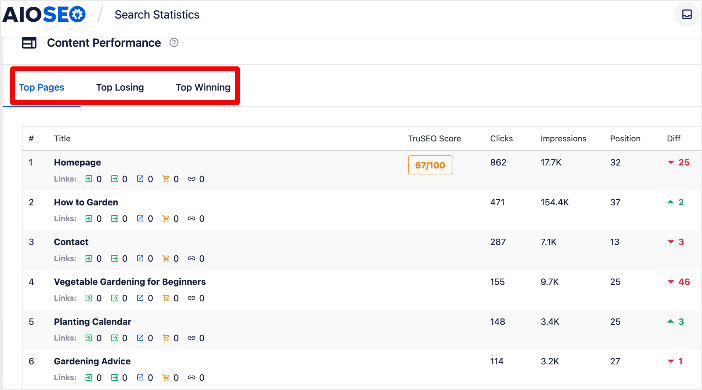
The report gives you insight into essential data like Clicks, Impressions, Position (on SERPs), and the Difference in ranking position (Diff) over a specified period. These are all crucial to help you understand whether your SEO strategy is working.
A particularly useful metric in this report is the Diff. Keeping tabs on this is essential as it shows you whether your content is going up or down in rankings. Of course, if it’s going up, it means you’re doing something right.
However, if your content is going down, that’s a cause for concern. It means less traffic to your site. You can get an overview of the content that’s going down in rankings by clicking on the Top Losing tab in the Content Rankings report for your posts that are losing rankings.
Keeping Tabs on Content Performance Through the Keyword Rankings Report

The Keyword Rankings report is an invaluable tool that shows keyword performance over some time. It also shows you the keywords losing ground on SERPs and those that are winning.
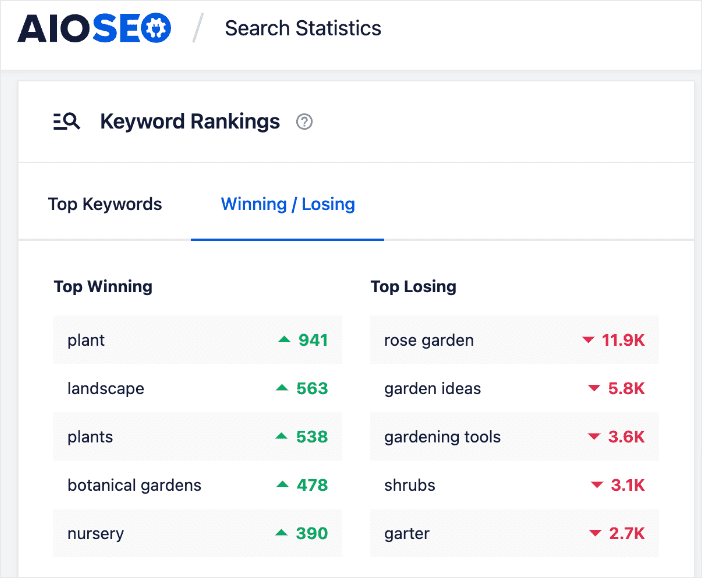
Armed with this data, you can implement tactics to help boost your SEO for the losing keywords and ensure your winning content continues to rank well.
How do you help ensure your content is always on an upward trajectory?
One of the best ways to do that is by regularly updating content. Search engines love fresh content as it has the potential to have the latest information users love. This is why content updates should be an important part of your SEO strategy. When updating your content:
- Ensure you’ve optimized for your keyword by including it in your headline, SEO title, meta description, heading tags, content, and URL.
- Ensure there are no dates in your title. If you want to use dates, make sure they are current.
- Add relevant internal links.
- Update your meta description (more on this in a moment).
- Update images if necessary.
Another important thing to remember when creating content for your website is to focus on evergreen content. This is content whose relevance transcends time.
2. Boosting Your Rankings in Positions 2-4: Increase Your Clickthrough Rates (CTR)
Being on the first page of SERPs is good. However, being in position #1 is the best. According to research, listings on position #1 of SERPs get almost a third of all the traffic. In addition, the same study shows that moving one position higher on SERPs results in a 2.8% increase in clickthrough rates (CTR).
This means being on the first page of SERPs is not enough if you’re to outperform your competitors. You need to be on top of the page.
And the best way to improve your position when you’re in positions 2-4 on SERPs is to increase your CTR. The more people click on your search listing, the more search engines deem it valuable to users, resulting in a boost in rankings.
Here are a few ways to help you increase your CTR:
Add Schema Markup
Schema markup helps search engines better understand your content. It also helps them produce better rich snippets, making your content more attractive on SERPs. The additional information in the rich snippets also helps readers know that your content will meet their needs. This will result in more clicks.
Some of the most impactful schema types you can add to your content include:
- FAQ schema: Answer questions readers will most likely ask and add FAQ schema.
- How-To schema: Add How-To schema for tutorials or instructional posts so search engines can output snippets with the steps required for the process you’re explaining.
- Local Business schema: This is excellent for brick-and-mortar businesses and helps you rank high for local searches.
For more information on how schema markup can help boost your rankings, check out this detailed guide.
Optimize Your Metadata
Another way to boost your CTR is by optimizing your metadata. This refers to elements like your SEO title, meta description, and URL.
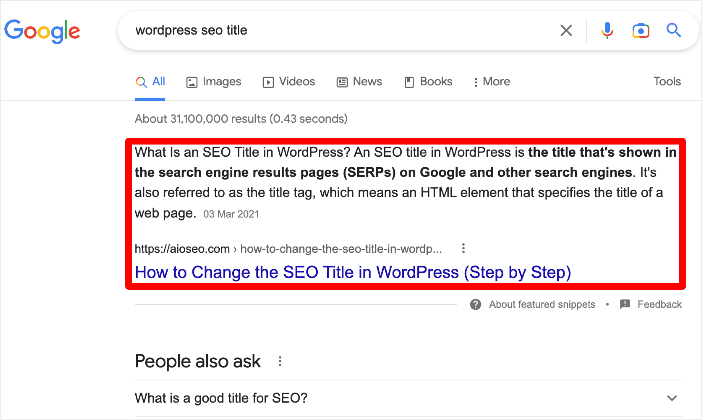
Optimizing your metadata is super easy. A few tips for that are:
- Include your focus keyword
- Paint a picture of the benefits users will get when they click on your listing
- Promise to meet user intent
You can edit your metadata easily in AIOSEO’s general settings tab. Additionally, you can preview what your search listing will look like on SERPs using AIOSEO’s SERP Preview tool.
For more tips, check out our guide on crafting meta descriptions that boost CTR.
Both schema markup and metadata may not be ranking factors, but they’re fantastic ways to boost your CTRs. And with that boost in CTR comes an improvement in your rankings.
3. Boosting Your Rankings in Positions 4-7: Boost Your Visibility
Is your content in positions 4-7, and you’re struggling to reach the top 3?
While content ranking in these positions gets a decent amount of traffic, you can still do better. And with the right strategy, you can.
To help you move up in position, you’ll need to boost your visibility on SERPs. Doing so will help you drive more traffic to your pages and increase engagement. Both are signals search engines use to rank content.
To boost your visibility on SERPs:
Implement Schema Markup
As you’ve already seen, Schema markup is a great way to generate rich snippets. Because they have more information than traditional listings, they’re more interactive. They are also more visible on SERPs. Take a look at this example of a listing outputting FAQ schema:
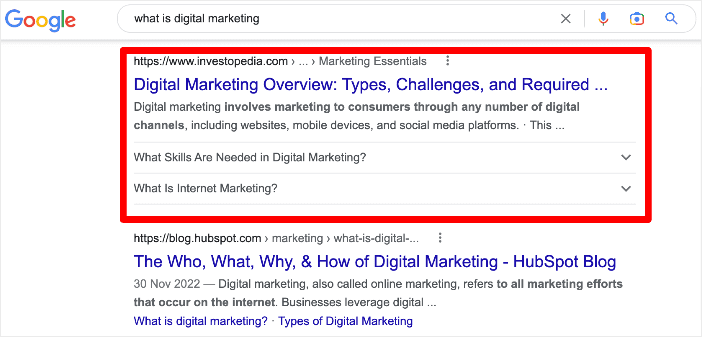
The listing is more prominent than other listings on the SERPs, even a listing higher than it. Because of this, it’s more likely to drive more traffic than the listing above it. This can lead to its ranking improving.
Generate Jump links on SERPs using the Table of Contents block
Another way to boost your visibility on SERPs is by creating jump links. Jump links, or anchor links, are hyperlinks you click on to jump to another section of the same web page. These are important for SEO because search engines sometimes display them in search results. Displaying jump links on search results makes your search listing stand out.
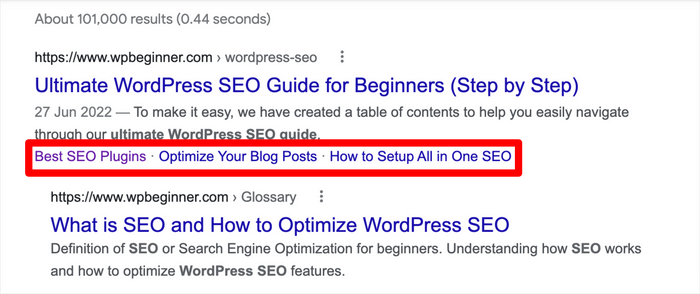
One of the easiest ways to increase the chances of getting jump links in your search listings is to add a table of contents to your posts or pages. AIOSEO makes this super easy as it comes with a powerful table of contents block that automatically creates a table of contents for you.
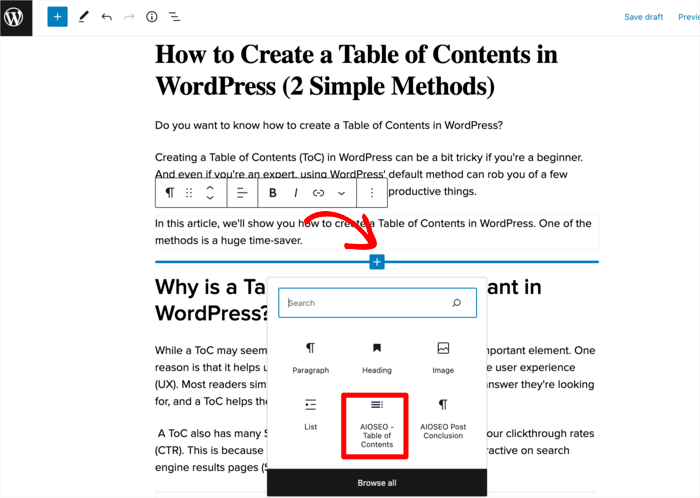
You can easily customize your table of contents and hide some sections you want to hide.
For detailed instructions on adding a table of contents in WordPress, check out this guide.
Adding schema markup and a table of contents are 2 of the best ways to boost your visibility on SERPs. And the more visible your search listings are, the better your CTRs, resulting in better rankings.
4. Boosting Your Rankings in Positions 7-10: Audit Your Content
If you’re in positions 7-10 of SERPs, you’ve actually done a great job with your SEO. It means you’re on the first page of Google.
However, despite being on the first page, you still need to push your rankings up if you’re to get maximum traffic. So for content that’s in positions 7-10, your best course of action would be to bump that content up to position 6 or better.
The best way to do that is to run a content audit.
Of course, the first step would be to use Search Statistics to check your content’s performance.
A few tips for auditing your content include:
Define Your Content Goals
What do you want your content to achieve?
Is it lead generation, driving sales, or is it meant to educate your customers?
Defining your content marketing goals will help you see whether your content is written and structured to fulfill those goals.
If your content isn’t optimized for your goals, consider rewriting it or revising it to align more with what you want to achieve.
Check if You’re Targeting the Right Keywords
Sometimes when creating content, you may find a keyword that looks great. It may have good volume but may not meet your target audience’s search intent. So, while it may rank well, it can get crippled by high bounce rates. And high bounce rates indicate to search engines that your content doesn’t satisfy users.
The easiest way to solve this problem is to check and steal your competitors’ keywords.
Once you’ve discovered the right keywords to be targeting, use AIOSEO’s TrueSEO to optimize your content better.
Audit Your Internal Links
Internal linking is another powerful way to boost your search rankings. That’s why you should consider auditing your internal links when your content struggles to move up when in positions 7-10 of SERPs.
With AIOSEO’s Link Assistant, this is super easy. Link Assistant is a powerful tool that gives you an overview of all the links on your site. These include inbound internal links, outbound internal links, inbound external links, and affiliate links.
It also shows you internal linking opportunities as well as orphan pages.

This helps you create strategic internal links to help give your content a boost.
The best part about Link Assistant is that it can automate internal link building. This means you can execute this strategy quickly and get results faster.
For more information on how to use Link Assistant, check out this detailed tutorial.
5. Boosting Your Rankings in Positions 10-15: Audit Your Technical SEO
Research shows that 75% of users never go past the first page of Google. And positions 11-15 are on the second page of SERPs. You’ll still barely get any traffic, despite being ahead of millions of other search listings. This is why you need to tweak your SEO strategy to help you break through to page 1.
One way to do this is to audit your technical SEO.
Technical SEO refers to optimizing the technical elements of your website and server that impact your:
- Performance
- User experience (UX)
These two primary elements impact how users and search engines appreciate your website. They also have a bearing on your rankings as sites with good technical SEO perform better in search.
Essential technical SEO elements you need to get right include:
Loading Speed
Loading speed is a critical aspect of technical SEO. That’s Search Statistics has a tool to test your page loading speeds.
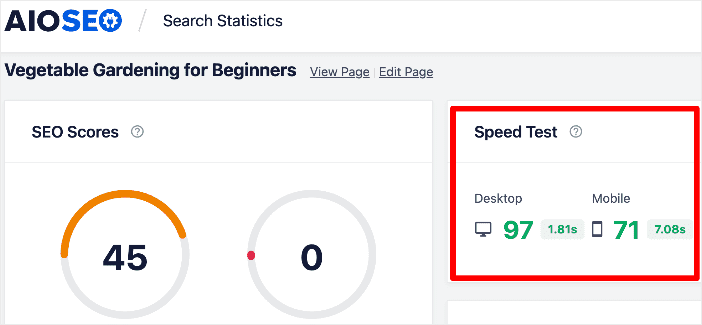
Sites and pages that load slowly are penalized as they don’t offer users a good Page Experience. They also don’t meet Google’s Core Web Vitals, a set of metrics the search giant uses to determine a page’s overall UX. Here’s a summary of what they are:

A few ways to include your loading speed include:
- Use a theme built with SEO in mind
- Pay attention to image SEO
- Use a caching plugin
For other ways to speed up your WordPress site, check out this article.
Check if Permalinks are Optimized
Permalinks play an essential role in technical SEO as they determine site structure. As a result, they can better crawl your site and index your pages more efficiently. This leads to better rankings.
While WordPress assigns default permalinks to your posts and pages, these aren’t optimized. So for SEO-friendly permalinks, you’ll have to put in a little work and customize them for each individual page, especially by including your focus keyword.
For other tips on optimizing your permalinks, you can read this guide.
Check for Crawl Errors
If search engines struggle to crawl your site, it can negatively impact your SEO. That’s why your technical SEO audit must include a check for crawl errors. Two of the most common causes for crawl errors include:
- Broken links: Broken links are another factor that can negatively affect your technical SEO. Eliminate them by implementing redirects using our powerful Redirection Manager.
- Redirect chains: This is a situation where one redirect leads to another, and another, and another, and so forth. Always keep track of your redirects to prevent this from happening.
Auditing your site for crawl errors and fixing them pays off in a boost in rankings. It could be what you need to take you to the first page of Google, where most of the action is.
6. Boosting Your Rankings in Position 15-20: Perform Competitor Analysis
Positions 15-20 are the bottom half of page 2 on SERPs. That’s a decent position. However, it doesn’t bring many results and business growth. Remember, users hardly go past page 1 of Google, so you should put in more effort to get your content to move up the ranks until you reach the top spot on the first page.
To do this, perform a competitor analysis to see what your competitors are doing that you aren’t. This will also help you identify ranking opportunities. A few tips to help you conduct an impactful competitor analysis include:
Identify Your Competitors
The first step to performing a competitor analysis is to identify your competitors. These can fall into 3 main categories:
- Direct competitors: These are in the same business vertical as you and compete for the same keywords and customers.
- Indirect competitors: These compete for the same keywords and target a similar audience but don’t sell the same product you do.
- Replacement competitors: These may not offer the same product you do but instead provide an alternative solution.
Once you’ve identified your competitors, you can dig deep into their SEO strategy to see how to best tailor yours for success.
Perform A Competitor Analysis Using AIOSEO
Performing a competitor analysis is not as difficult as it sounds if you have the right tools. And one of the tools you can use to do this is AIOSEO’s SEO Analysis feature.

Simply enter your competitor’s URL, and the plugin will dig into their SEO strategy and give you a detailed report.
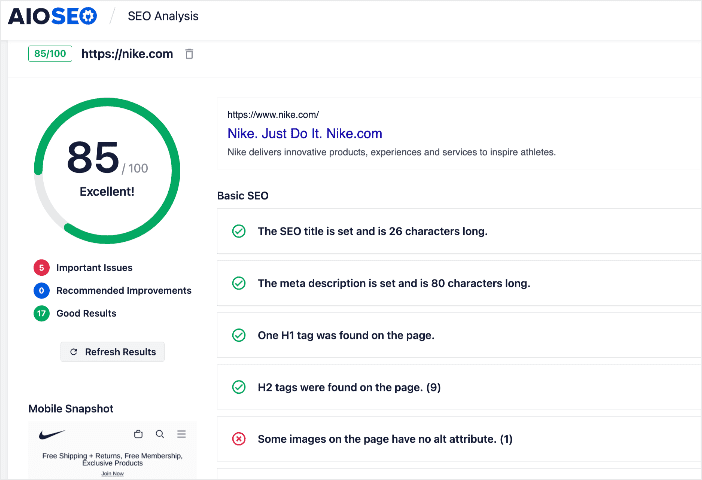
The report includes aspects like basic and advanced SEO, performance, and security issues.
Check out our guide on how to perform a competitor analysis for detailed steps.
Once you have gathered all the data on your competitors, use it to find common threads in their SEO strategies. Reverse engineer these and replicate them on your site. You may also find some unique insights that are uncommon among competitors. You can also implement them if they are safe and don’t seem like black hat SEO tactics.
Search Statistics Power Hacks: Boosting Your Rankings and Growing Your Business.
Search Statistics is an invaluable tool you should be using regularly to help you monitor your search performance. And with the tips outlined in this article, we’re confident you’ll be able to move up in search rankings.
We hope this article has helped you learn some power hacks to help you improve your search rankings. You may also want to check out other articles on our blog, like our ultimate WordPress SEO guide or our blog post SEO checklist.
If you found this article helpful, then please subscribe to our YouTube Channel. You’ll find many more helpful tutorials there. You can also follow us on Twitter, LinkedIn, or Facebook to stay in the loop.
Disclosure: Our content is reader-supported. This means if you click on some of our links, then we may earn a commission. We only recommend products that we believe will add value to our readers.
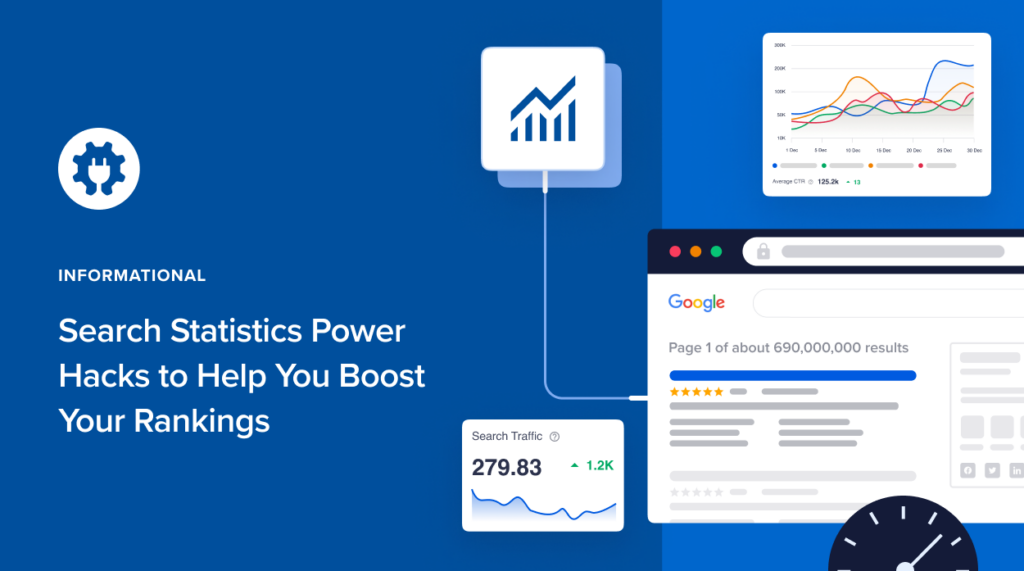

Thank You for providing me the best seo knowledge. I think that your blog really helpful for me to rank my website.
This pages title needs to be updated from “7 Search statistics” to “6 Search statistics”
Thank you so much, Marcus. Done!